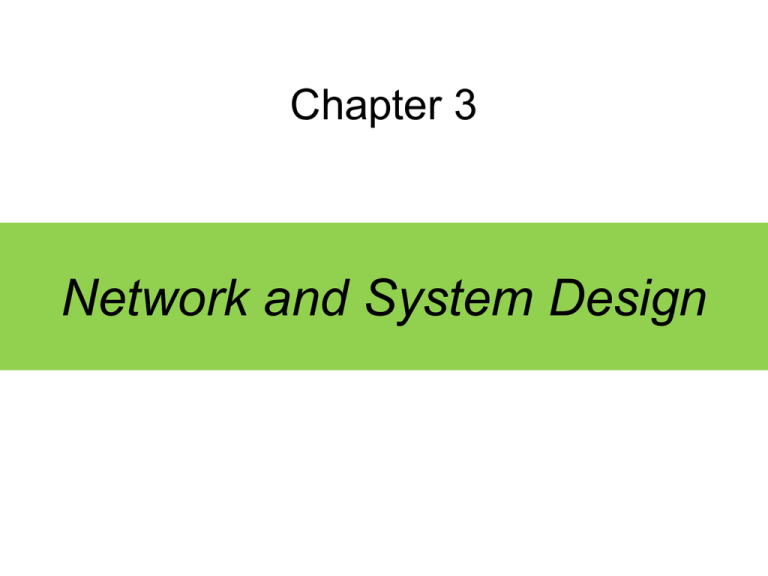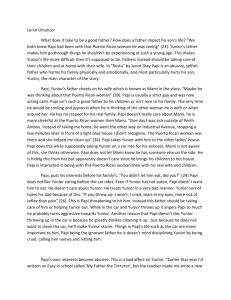Chapter 3
advertisement

Chapter 3
Network and System Design
Capacity Implications
Linked supply chain organizations need to match capacities to avoid
bottlenecks
Common measures:
• Design Capacity - maximum output rate that can be achieved, i.e.
maximum capacity
A theoretical number
• Effective (or available) Capacity - maximum output rate that can be
sustained under normal conditions
• Actual Capacity which contains planned and unplanned losses.
Actual output
Design Capacity
Effective Capacity
Planned loss
Planned loss
Unplanned loss
Capacity Utilization
Capacity utilization indicates how much of capacity is actually being used
Calculation:
Efficient: The efficient use of the resources:
Actual output
(100%)
Efficiency =
Effective Capacity
Capacity Utilization: The measure of how much of the
available capacity is used
Actual output
Utilization = Design Capacity (100%)
3-3
Capacity Utilization Example 2
Example 2
A factory produces the following 3 types of computers with the
following assembling times:
(α) laptop: 4 min,
(b) netbook: 3 min, and
(c) tablet PC: 5 min.
In the next 3 months, the available assembling time is 31900 minutes
and demand follows the relationship (α):(b):(c) = 3:4:1.
Calculate the number of computers produced.
Answer
(α):(b):(c) = [3x4] + [4x3] + [1x5] = 12 + 12 + 5 = 29 mins.
Therefore the number of computers produced:
31900/29 = 1100 computers per 3 months
3-4
Capacity Utilization Example 3
Example 3
Imagine you are managing a group of 10 electricians. They
undertake in-home servicing of electrical systems, and are called
by telephone for either emergency or pre-arranged visits. They
charge a minimum call-out fee that covers the first 15 minutes of
their visit plus travelling time. Beyond the first 15 minutes they
charge in blocks of 15 minutes, plus the cost of any materials that
they need to complete the job. The average call-out takes 1 hour.
The electricians are usually available for eight hours a day but,
with two coffee breaks of 15 minutes each and a half-hour lunch
break, they actually work a seven-hour day. Taking time off and
illness into account, the electricians’ available time reduces by
20%. This means the seven-hour day is reduced to a day of 5
hours 36 minutes (i.e. 5.6 hours)
Problem: If actual work is only 200 billed hours in the week
then: (a) What is the capacity utilization of the team? (b)
What is their efficiency?
3-5
Capacity Utilization Example 3
Example 3
Approach:
First you need to calculate (a) the design capacity and (b) the effective capacity. Then
use the actual output given above to calculate the capacity utilization and efficiency.
10 workers × 7 hours per day
Design capacity = ---------------------------------------- × 5 days of a working week
1 hour per customer
= 350 customers per week
10 workers × 5.6 hour day
Effective capacity = --------------------------------------- × 5 days of a working week
1 hour per customer call-out
= 280 customers per week
(a) If actual work is only 200 billed hours in the week, then what is the capacity utilization
of the team?
Utilization = {[Actual output 200] / [Design capacity 350] } × 100 = 57%
(b) If actual work is only 200 billed hours in the week, then what is their efficiency?
Efficiency = {[Actual output 200] / [Effective capacity 280]} × 100 = 71%
3-6
PROBLEMS
1.
Shex Hotel can accommodate 300 guests in a single day under maximum conditions.
However, under normal conditions this hotel is designed to accommodate 200 guests per day. In September, the hotel
accommodated 150 guests in one day. What is the hotel’s capacity efficiency & utilization?
Utilization effective = 150 guests / 200 = .75 x 100% = 75%
Utilization design = 150 guests / 300 = .5 x 100% = 50%
2.
Leopard Transportation company is designed to process 80 orders per day but can process as many as 100 orders per day
under extreme conditions. For the past month, it has processed 90 orders per day. What is the company’s capacity
efficiency & utilization? What comments can you make regarding its processing rates? Can the company maintain this?
Utilization effective = 90 orders / 80 = 1.125 x 100% = 112.5%
Utilization design = 90 orders / 100 = .9 x 100% = 90%
The company would not be able to sustain this utilization without existing and additional constraints increasing within the
system. They will need to apply specific focus on managing the constraints.
3.
Papi Toys can produce 500 toys in a single day under maximum conditions. However, it is designed to produce 400 units
per day under normal conditions. In February, it produced 480 units per day. What was Papi Toys’ capacity utilization for
both design and effective capacity? What do these numbers tell you?
Utilization effective = 480 orders / 400 = 1.2 x 100% = 120%
Utilization design = 480 orders / 500 = .96 x 100% = 96%
The current output of the warehouse is higher than effective capacity. Papi toys would only be able to operate at this
level for only a short period of time. Constraints would need to be managed closely.
3-7
3-7







